The Intel Core Ultra 7 155H Review: Meteor Lake Marks A Fresh Start To Mobile CPUs
by Gavin Bonshor on April 11, 2024 8:30 AM ESTASUS Zenbook 14 OLED UX3405MA: AI Performance
As technology progresses at a breakneck pace, so do the demands of modern applications and workloads. As artificial intelligence (AI) and machine learning (ML) become increasingly intertwined with our daily computational tasks, it's paramount that our reviews evolve in tandem. To this end, we have AI and inferencing benchmarks in our CPU test suite for 2024.
Traditionally, CPU benchmarks have focused on various tasks, from arithmetic calculations to multimedia processing. However, with AI algorithms now driving features within some applications, from voice recognition to real-time data analysis, it's crucial to understand how modern processors handle these specific workloads. This is where our newly incorporated benchmarks come into play.
Given makers such as AMD with Ryzen AI and Intel with their Meteor Lake mobile platform feature AI-driven hardware, aptly named Intel AI Boost within the silicon, AI, and inferencing benchmarks will be a mainstay in our test suite as we go further into 2024 and beyond.
The Intel Core Ultra 7 155H includes the dedicated Neural Processing Unit (NPU) embedded within the SoC tile, which is capable of providing up to 11 TeraOPS (TOPS) of matrix math computational throughput. You can find more architectural information on Intel's NPU in our Meteor Lake architectural deep dive. While both AMD and Intel's implementation of AI engines within their Phoenix and Meteor Lake architectures is much simpler than true AI inferencing hardware, these NPUs are more designed to provide a high efficiency processor for handling light-to-modest AI workloads, rather than a boost to overall inferencing performance. For all of these mobile chips, the GPU is typically the next step up for truly heavy AI workloads that need maximum performance.
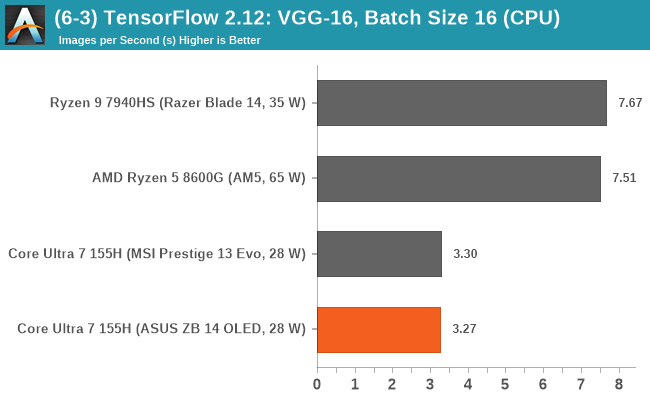
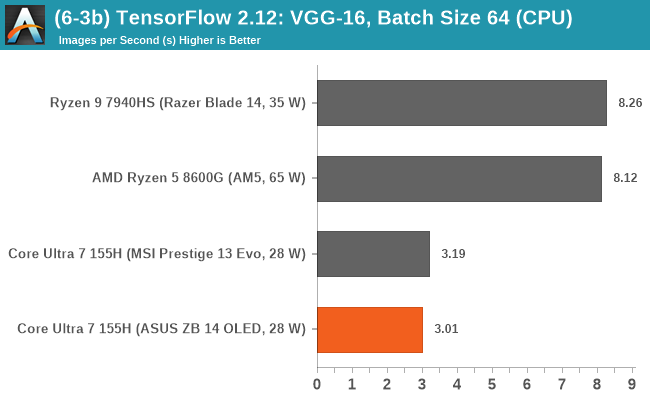
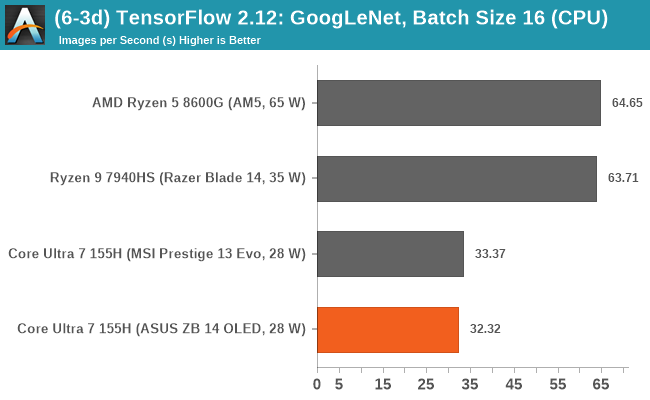
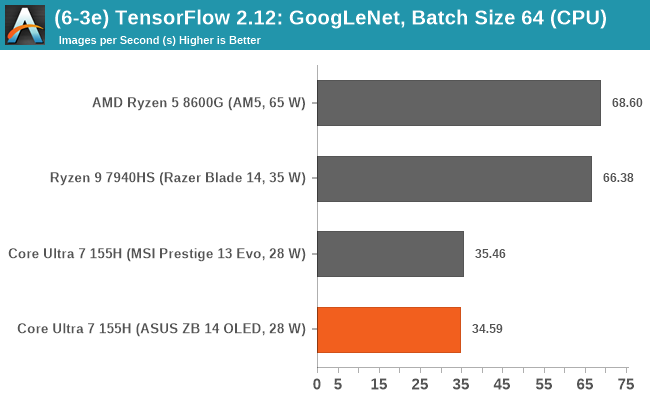

Looking at performance in our typical TensorFlow 2.12 inferencing benchmarks from our CPU suite, using both the VGG-16 and GoogLeNet models, we can see that the Intel Core Ultra 7 155H is no match for any of the AMD Phoenix-based chips.
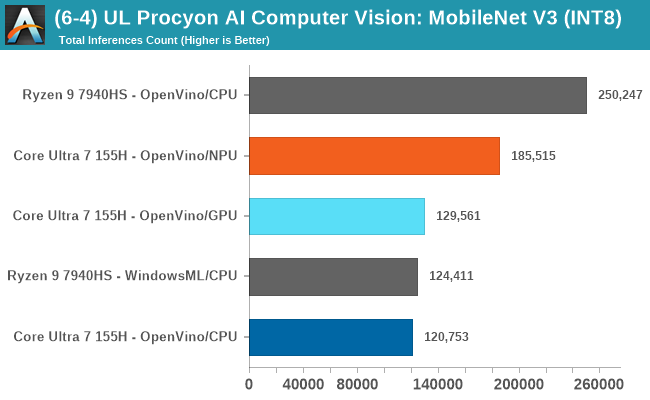
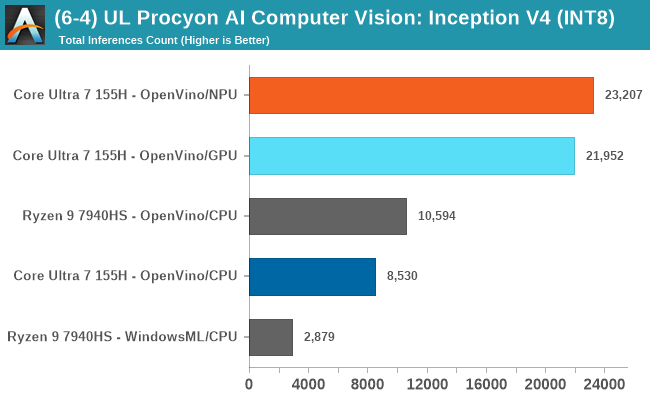

Meanwhile, looking at inference performance on the hardware actually optimized for it – NPUs, and to a lesser extent, GPUs – UL's Procyon Computer Vision benchmark collection offers support for multiple execution backends, allowing it to be run on CPUs, GPUs, or NPUs. For Intel chips we're using the Intel OpenVINO backend, which enables access to Intel's NPU. Meanwhile AMD does not offer a custom execution backend for this test, so while Windows ML is available as a fallback option to access the CPU and the GPU, it does not have access to AMD's NPU.
With Meteor Lake's NPU active and running the INT8 version of the Procyon Computer Vision benchmarks, in Inception V4 and ResNet 50 we saw good gains in AI inferencing performance compared to using the CPU only. The Meteor Lake Arc Xe LPG graphics also did well, although the NPU is designed to be more power efficient with these workloads, and more often as not significantly outperforms the GPU at the same time.
This is just one test in a growing universe of NPU-accelerated appliations. But it helps to illustrate why hardware manufactuers are so interested in NPUs: they deliver a lot of performance for the power, at least as long as a workload is restricted enough that it can be run on an NPU.
That all being said, even with the dedicated Intel AI Boost NPU within the SoC tile, the use case is very specific. Even trying generative AI within Adobe Photoshop using Neural fillers, Adobe was relying much more on the CPU than it was the GPU or the NPU, which shows that just because it's related to generative AI or inferencing, the NPU isn't always guaranteed to be used. This is still the very early days of NPUs, and even just benchmarking them for an active task remains an interesting challenge.


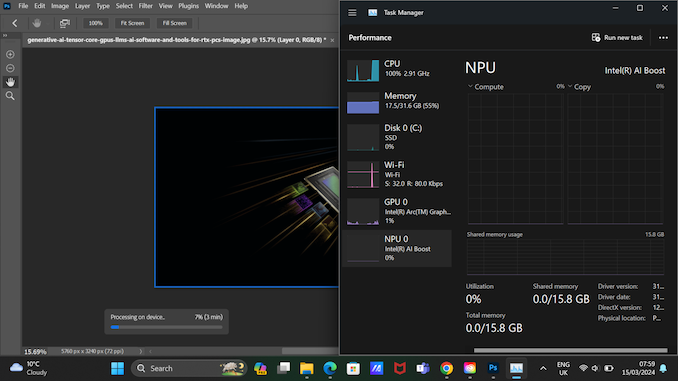








69 Comments
View All Comments
jeenam - Friday, April 12, 2024 - link
I've been an anandtech reader since 1998 or so and I'm not here to pick a bone. I'm a fan, and hope AT lives on. But did a quick search and the only two major websites with GPU reviews that referenced Returnal or Company of Heroes were Hot Hardware and Ars Technica. An expanded test suite of games might have been more appropriate because it's likely the ARC GPU would have been handily beaten across the board. Replysjkpublic@gmail.com - Thursday, April 11, 2024 - link
Strange. Some of the tests list the 155H as 28W with test results. This is misleading as the SoC uses much more power doing the test. ReplyGavin Bonshor - Friday, April 12, 2024 - link
When we review CPUs, especially when highlighting them in the charts, we list the base TDP, as every motherboard has its own interpretation of what level of power it will push through the chip (Multi-core enhancement). ReplyCarmen00 - Friday, April 12, 2024 - link
Yet in another comment, we have Ryan Smith saying "With these integrated devices, we're reviewing the notebook as much as we're reviewing the chip inside."So if you're doing what he says—post the right numbers, because that's what you're doing. And if you're NOT doing what he says, then don't post useless stuff that seems, to my (perhaps overly-critical eye) to exist so that the article can claim that Intel is scoring SOME kind of a win, when the graphs really don't seem to show a heck of a lot of CPU-related win.
I'm fine with either, let me be honest. But I want to see some consistency, that is all. Reply
Ryan Smith - Friday, April 12, 2024 - link
I'm all for trying to make sure you guys get the data that you want to see. But not sure I follow here. We are being consistent in our testing methodology, and taking care to be explicit in that our test systems don't have identical TDPs.https://images.anandtech.com/doci/21282/Core%20Ult...
In a laptop, sustained TDPs are our primary concern, as these devices cannot turbo multiple cores for more than a few seconds. So this is what we're noting in an article like this, to illustrate how we aren't testing devices with matching TDPs. Reply
ballsystemlord - Friday, April 12, 2024 - link
I agree with Ryan here, sustained performance is what you should be looking at. Anything can turbo to infinity.The only real use case for turbo, would be application start-up. But even then, you'd have to be waking the PC from idle and selecting the application in record time for it to matter at all. Reply
lmcd - Wednesday, April 17, 2024 - link
The problem I'm seeing is that this article takes the format of previous laptop reviews but not the depth (in part due to the declining access this publication), and the headline could better fit the contents. It could even be something silly like "The Intel Core Ultra 7 155H Review: Meteor Lake starts with a Moment of Zen(Book)" and be more valuable to the reader.It also did not feel like we really got (even a rehash of) an overview of Meteor Lake as a platform. So to me, this was an ASUS Zenbook review. Framing this as "ASUS ZenBook 14 OLED: A Meteor Lake Thin&Light Review" also better captures its content. Reply
eastcoast_pete - Friday, April 12, 2024 - link
I am not surprised that the Core 7 Meteor Lake isn't beating the Ryzen 7840HS in compute or graphics - that particular Ryzen 4 monolith is (IMHO) currently AMD's best foot forward, and a great APU. However, Intel did do its homework when it comes to the intended use of Meteor Lake SoCs: mobile, especially light and ultralight laptops and 2-in-1s. I don't expect a ~ 1 kg notebook to do that much higher level gaming or compute. I do expect long runtime on battery, fluid use of office and other productivity apps, and otherwise decent performance (speed). Again, AMD's Phoenix/Hawk APUs are, right now, the most performant solutions in that class, but it's good news for all of us that Intel has closed the gap. It'll mean that AMD will have to keep evolving its APUs, and maybe do a better job making them broadly available with good drivers within a few months of announcing them. Because that was not the case with Phoenix, which just took too long to be ready for prime time, and left the opening for Intel to move back into.Lastly, I find that one of the most remarkable things about Meteor Lake is that Intel got its tile design and packaging working quite well. Being able to combine different chips from different fabs (Intel and TSMC) and nodes into a cohesive unit without incurring large hits on performance and efficiency is big step forward. Reply
nandnandnand - Saturday, April 13, 2024 - link
Lunar Lake will be the one to watch. It's Meteor Lake-U evolved (4+4 instead of 2+8, on-package memory by default, decent graphics). Low power mobile chips are more interesting than the 45W+ ones. Replymode_13h - Monday, April 15, 2024 - link
> Being able to combine different chips from different fabs (Intel and TSMC)> and nodes into a cohesive unit without incurring large hits on performance
> and efficiency is big step forward.
AMD combined chiplets from both TSMC and Global Foundries in the same CPU, all the way back in Zen 2! If you count HBM, they combined chiplets from different foundries as far back as their HD Fury GPUs.
As for performance and efficiency, I find Meteor Lake underwhelming on both fronts. Idle performance and things like video playback gain a benefit from the new SoC architecture, but when it comes to compute-intensive tasks, we see why Intel kept around Raptor Lake for the performance-oriented segment. Reply